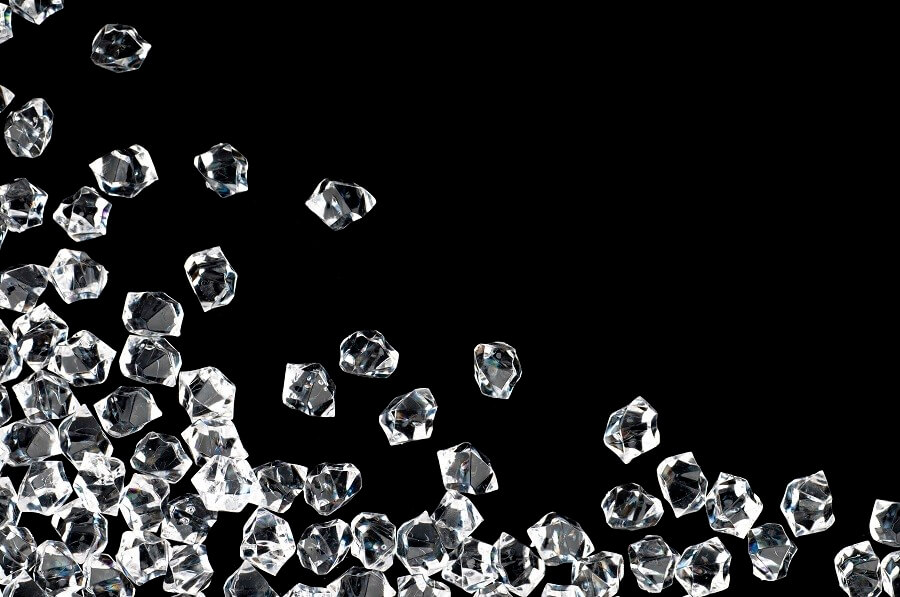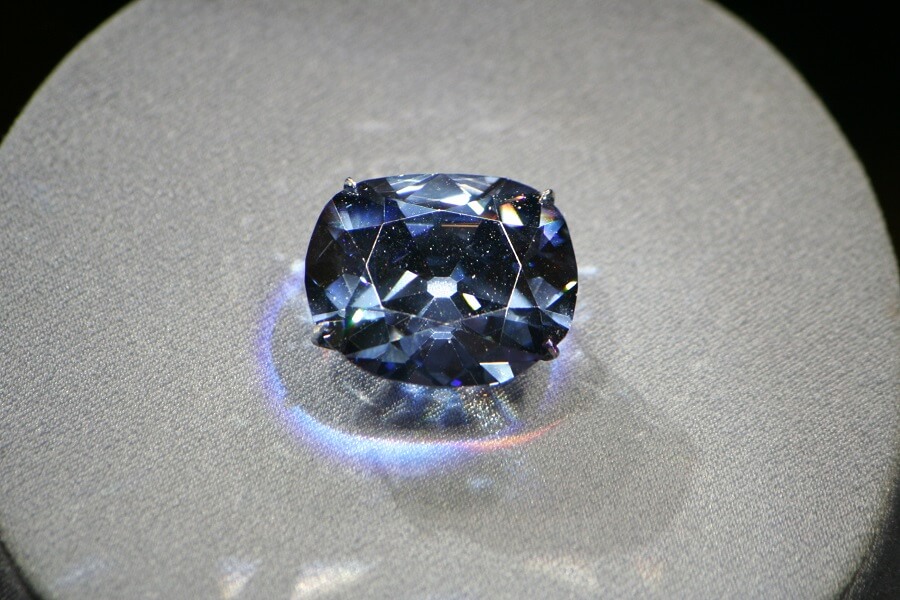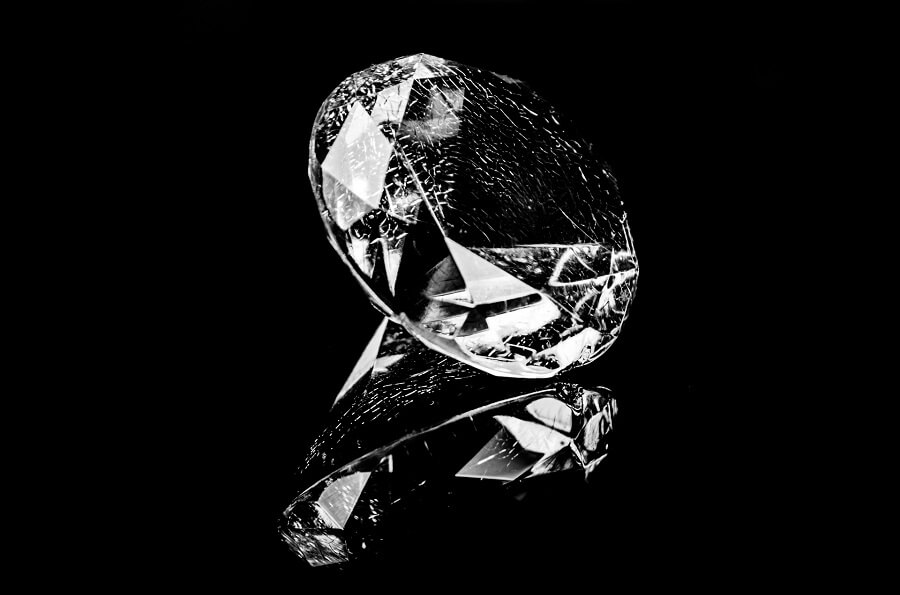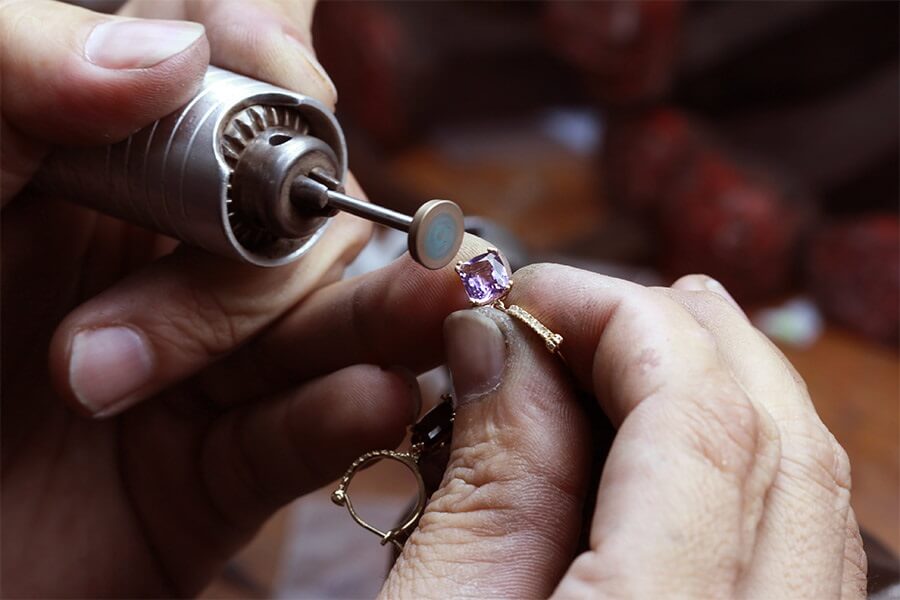Rarity is the podium on which diamonds rise above other precious stones, but not the only factor to determine their value. Buying a stone is an exciting and considerable investment, but never an easy task. On top of a jeweler’s loupe, a diamond quality chart is the next best tool to help you measure the value and the cost of a diamond.

A jeweler’s loupe will ensure you’re satisfied with the cut of the diamond. The diamond quality chart includes a grading system that describes the individual qualities of each stone. The value of a diamond is therefore based on the 4Cs: Carat, Cut, Clarity and Color.
This is the language that jewelry professionals and diamond seekers use alike, and we’ll help you become a proficient speaker yourself.
The 4Cs Mapped on a Diamond Quality Chart
The 4Cs have a long history. Three of them—color, clarity, and carat weight— were first established in India over 2,000 years ago. The Gemological Institute of America (the G.I.A.) developed the international grading system.
Carats on the Diamond Quality Chart

Some goods you purchase by weight – ounce, pound, kilogram, liter, or ton. In the diamond world, carats represent the unit of weight.
One metric carat is 0.2 grams. Translated in ounces, you get 142 carats for one ounce. A small paper clip weighs about a carat. Your standard engagement ring stone will most likely not even equal that small paper clip in weight.
So the industry came up with a new unit of measure for those diamonds that don’t make the metric carat cut: points. Each carat is divided into 100 points.
A diamond that weighs 0.83 carats is said to weigh “eighty-three points”. Or, you can simply call it an “eighty-three pointer.”
A diamond can be weighed to a thousandth (0.001) of a carat. Fractions of a carat can cut price differences of thousands of dollars.
The main idea to take out of the carat lesson is that a carat is not size – a common misconception, but weight. A well-cut diamond will appear larger than a badly cut diamond, even if in weight they’re the same.
Color on the Diamond Quality Chart

Even if you only know your diamonds from what Kate Winslet was wearing in the Titanic or from stories you’ve heard about the ocean blue Hope diamond, you’re aware by now that these precious stones come in many colors.
Subtleties abound within the color range, and different price tags hang on identifying them. Two diamonds may share the other 3Cs – clarity, weight, and cut, but if they differ in color the value will follow accordingly.
On the diamond quality chart, normal colors are yellow, brown or gray. Within this range, colorless diamonds are rare birds.
Round brilliant diamonds of color, known as master stones, set the standard for pricing and grading in the GIA Laboratory.
In this case, color is graded from D to Z. Each letter is a color based on a diamond’s tone and saturation. D is the colorless type, the most expensive, valued, and desirable.
The transition to the next letter in the diamond alphabet is hard to notice to the amateur eye. Don’t feel bad, though, even an expert has to compare it with another stone to tell the difference. At the bottom end of the scale, a Z diamond is noticeably yellow.
Exposed to ultraviolet radiation, a diamond responds. It emits a visible light which we know by the term of fluorescence. You can spot fluorescence in about 35 percent of gem diamonds.
Fluorescence is also called the diamond’s ability to ‘soak up light’. The precious stones get grades for this characteristic as well. From None to Strong, it can affect the value of the diamond.
If you find a hint of blue within the stone, you’re dealing with a gem-quality diamond. In rare instances, you may encounter white, orange, or yellow fluorescence.
Blue and yellow are color opposites and cancel each other out. Over the blue fluorescence, the yellow color is not apparent.
However, you don’t want an overdose of fluorescence in the diamond. If it’s too strong, it can make the stone look cloudy or “oily,” which can lower the value of the diamond.
Cut on the Diamond Quality Chart

The quality of a cut can make the difference in a diamond’s value. A badly cut stone can ruin a naturally priceless diamond. It’s the reason cutters are usually under a lot of pressure.
A flawless diamond, if delivered in the hands of an unskilled cutter, may turn out lifeless and dull. A diamond’s value revolves around unbounded radiance.
The proportions we measure a perfect cut now were determined at the turn of the century. Before this, the aim was to polish the rough diamond as little as possible so the gem remained as big as possible. No waste of the precious material.
Nowadays, the accent is laid on brilliance rather than size. The cut is largely dependent on the skill of the cutter. If done correctly, it can create the maximum sparkle and shine. The light that enters the diamond must be reflected back to the beholder.
More light means a better cut diamond.
Shape also became a criterion by which the cuts are made. Almost every cut sold for use in jewelry and commanding a premium is of round or square shape. Other popular shapes include:
- Oval – A modified brilliant cut that creates the illusion of a larger diamond.
- Cushion – A classic cut which has been used for 200 years.
- Emerald – The lighter and darker planes create a hall-of-mirrors effect with this kind of cut.
- Marquise – Narrow and long, the marquise cut has one of the largest surface areas of any diamond shape.
Clarity on the Diamond Quality Scale Chart
Diamonds come with birthmarks. If they’re found on the outside, we call them blemishes. If the flaws are internal, they’re known as inclusions.
Diamonds are born with these small imperfections deep inside the earth’s liquid magma. More imperfections translate to less brilliance because they will trip light in its path through the diamond.
The jeweler observes, identifies and grades the flaws with the help of a loupe. And he encounters inclusions a lot. Practically all diamonds contain natural flaws.
Still, perfection exists in the world of diamonds. Combine a flawless (F) diamond – the highest clarity diamond with a D color, and the result will be a truly rare stone.
What’s important is that the size, reflectivity, position, nature and amount of inclusions will not impede the cutter to perform his best on a rough diamond.

Almost all diamonds are graded according to the 11 point diamonds quality chart created by GIA. The GIA considers every flaw visible under 10X magnification. If it’s not seen at 10X, it will not affect clarity.
Even a skilled grader will have difficulty seeing under 10X magnification. This category of diamonds is known as the Very, Very Slightly (VVS) diamonds, and it’s divided between VVS1 – a high clarity grade and VVS2 – a lower one.
The diamond quality chart is the tool by which you get a better sense of what you value in a diamond. The 4Cs are there to establish the criteria by which you judge the future stone to set on your engagement ring.






